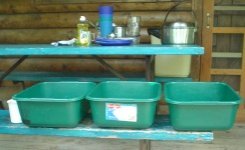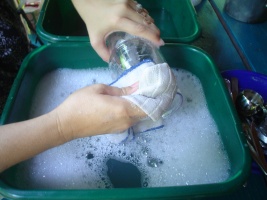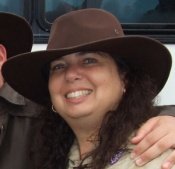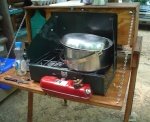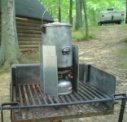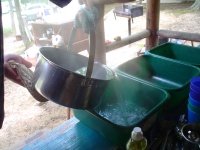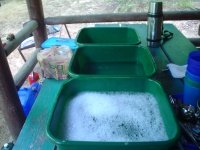Camping Dishwashing - How To Wash Dishes Without A Sink
Camping dishwashing seems to be a puzzling act for many people. This is one of the most frequent questions I get by visitors to this site...how to wash dishes when you are camping!
Most campers are environmentally concious and prefer to stick with reusable rather than disposable kitchen items but give in to the throwaways because washing dishes while camping seems like such a daunting or impossible task.
So here is the easy step-by-step camping dishwashing process that we faithfully use to wash dishes when we are camping. We use this method on both our family camping trips as well as our scouting trips where everyone brings a mess kit and there are no throwaway plates, cups, or utensils used.
What Equipment Do You Need??
When setting up our camping dishwashing station, first we start with the
equipment list. We keep all of things packed in our kitchen box...except for the water, the dirty dishes, and the human of course!
- Paper Towels
- Your Favorite Dishsoap
- A Dishcloth/Sponge/Scrubby
- Tongs
- Three Dishpans
- Hot Water
- Cool Water
- A splash of bleach or sanitizing tablets (optional)
- Dirty Dishes
- A Human Dishwasher Okay, footnote...while parents will do, we try to put younger kids on the first two dishtubs, older teenage types on the boiling water tub..hopefully with minimal sibling squabbling, which sometimes is worse than doing the dishes myself!
Step One: Heat The Water
Immediately after dinner is ready, we put two or three pots of water to boil on the stove while we are eating. Actually, we put two...and then do the third one afterwards because that is what works for us with the equipment we have. One pot will be in the largest cooking pot we have, for the other we use our coffeepot.
Step Two: Wipe The Plates
After dinner...and this is the only place we use disposable paper good item...everyone takes a paper towel and wipes their plate and silverware clean of any food particles. This can be done with one paper towel and it is an important step to help to keep the food particles out of the washtub. We put the paper towels in the fire ring to be burned later during our campfire.
Step Three: Set Up The Wash Tubs
Now it is time to get the three tubs out. You can work from left to right, or right to left, whichever works best for you.
I will call them A, B, and C to make it easy to follow along with the directions. I usually fill the tubs only halfway or a little more...not to the top.
These are just cheap ordinary rectangular dish tubs you can get
at Wal-Mart. They easily nest inside each other and you can put a bunch
of your kitchen stuff inside the top one for storage.
Step Four: Prepare The Tubs
Tub A is for washing. We put a few squirts of dish soap in here, then fill the tub halfway with regular water. You should be using an environmentally safe, biodegradable soap such as Campsuds or one of the Dr. Bronner's natural soaps. When the hot water is ready, we add some to warm this tub up. This is a personal preference. I like the water to be warm when I am washing the dishes while my husband likes cool water (which feels yucky to me!).
Tub B is the rinsing tub and gets just plain water in it. We fill the tub 1/3 of the way with cool water, and the rest (about 2/3) with hot water.
Tub C is for sterilization. This is a very important part of your camping dishwashing station...don't skip it!!! Some people like to use sterilization tablets, some put a few drops of bleach in the tub (health safety standards recommend 1 teaspoon of bleach for every 2 gallons of water)...but we use only pure boiling hot water. This is extremely hot and you will need tongs to pull the dishes out of this tub.
Step Five: The Washing Process
- Using a paper towel, thoroughly wipe any food residue off of the plates. You want as little food as possible to be in the tub when washing. One paper towel is good for wiping several plates.
- Start with the cleanest dishes first, leaving the dirtiest dishes, usually the pots and pans and mixing bowls, for last.
- The first dishes to be washed will be placed in Tub A with the soapy water and dishcloth or sponge, just like you do in a sink.
- After washing, the dishes come out of Tub A and into Tub B where you agitate a little to rinse off the soap.
- Now the dishes get moved from Tub B, the rinsing tub, to Tub C, sterilization. Be careful when you put the dishes in so you don't splash the hot water on yourself!
- Let the dishes sit a few minutes in the boiling water (Tub C) while you go back to Tub A and wash some more dirty dishes....put these washed dishes in Tub
B to rinse, and while they are in there, with the tongs take the clean, sterilized dishes out of Tub C.
- Spread some paper towels, or use a portable dish drainer if you like, and let them drip dry upside down (we do spread out paper towels for this which we reuse all weekend)
And that is it! Now in writing this, it sounds like a complicated procedure, partly because I really broke down the steps into baby steps to make sure I was explaining it well.
But really, camping dishwashing is very simple and easy to do. Your dishes are done in no time at all...and probably with a lot less water than you use at home!
Dumping the Dishwater
Be sure to read the next section to make sure you dispose of your dirty dishwater with as minimal impact as possible on the environment!!!
Now it is time to clean up the camping dishwashing area! The method that we use to dispose of the dishwater also sounds a little complicated....but it is not at all...and it is done this way to wash out and clean up your dishtubs without using any more water than you already used for the dishes!
- First dump out the water in Tub A. This was the washing water with the soap...and will be the dirtiest of the three tubs (remember...check out the minimal impact method of dumping your water in the next section!)
- Now...dump the rinse water from Tub B into the empty Tub A (this gives Tub A a rinse with water that you already have).
- Now...dump the boiling water (it won't be boiling hot anymore) from Tub C into Tub B. So now Tub C is empty and clean and you are done with it. Turn it upside down with your other clean dishes to dry.
- So now you have water in only Tub A and Tub B. Go ahead and dump the water from Tub A again.
- Now pour the water from Tub B into Tub A so Tub B is clean and empty, and Tub A is getting its final rinse with the batch of hot rinse water. Put Tub B upside down with the clean dishes to dry.
- Finally, dispose of the water in Tub A and turn it over to dry...and you are done! And your dishes are done too!
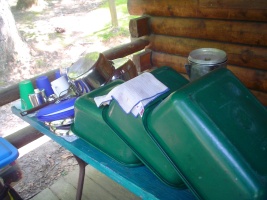
This is the method I learned 12 years ago when I was a Cub Scout mom and leader....and we have used it on every family campout and Boy Scout training and troop campout I have been on. We always set up a three-tub camping dishwashing station...and the dishes come out clean and, most importantly, sanitary.
Some Rules For Your Camping Dishwashing Station To
Both Keep Your Dishes Clean While Leaving Minimal Impact On The Environment
As campers we love nature and its beauty and try to do the best we can to promote Leave No Trace camping, or camping that does as little damage as possible to the environment.
There are many debates as to whether camping dishwashing, because you are using soap and water, and disposing of it, is more harmful to the environment than using paper and plastic disposables.
All of the research I have done points to camping dishwashing with resuable plates, pots, silverware, and cups, as being the preferred method...but here are some important steps you should take when washing your dishes at your campsite to make sure you protect the area so many can enjoy it in the future as well.
- If possible, use small quantities of biodegradable soap.
- Make sure you wash and dispose of the waste water at least 100 feet from any water source. Never pour it into a river or lake, or any water source as this will contaminate the water!
- If possible, dig a small hole to pour the water into, to allow the ground to filter the water and return it back to the water source in its own natural way. If you can't dig a hole, spread it over the ground to encourage natural filtration.
On many campouts I have seen people washing their dishes/pots/pans under a running spigot on their site. This is not an acceptable practice of camping dishwashing for several reasons. First, the running water is a huge waste of excess water! Second, the water is not being dispersed of properly to encourage natural filtration.
Yes, using the three-pan method for camping dishwashing takes a few extra steps than using a running spigot, but it is proper camping technique, sanitary for the environment...and for you, your family, and your dishes!

